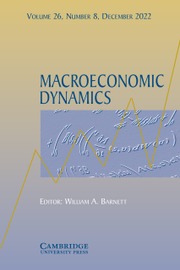No CrossRef data available.
Article contents
Greenflation, climateflation and monetary policy: the dynamics of sustainable transition
Published online by Cambridge University Press: 01 September 2025
Abstract
The green transition to reduce greenhouse gas emissions requires substantial investments in a narrow time window to avoid climate-related disruptions, adding two new dimensions for monetary policy and exacerbating the trade-offs that central banks face. First, climate-related physical disruptions lead to higher inflation (i.e., Climateflation). Second, the rush to green technology may result in inflation due to supply bottlenecks (i.e., Greenflation). As a consequence, central banks implement restrictive monetary policy that have a detrimental effect on the high up-front costs of renewable energy projects. This slows down the dynamics of green technologies adoption. We build a dynamic non-linear model to study these interactions under reasonable parameterizations. Both Climateflation and Greenflation are quantitatively significant, creating a dilemma for central banks between raising interest rates to counteract inflation and easing them to facilitate renewable investment. We further show that, under specific stochastic scenarios, the trade-off between inflation control and green transition can improve when structural costs for green technologies decrease or when supply-side constraints relax.
Keywords
Information
- Type
- Articles
- Information
- Copyright
- © The Author(s), 2025. Published by Cambridge University Press

